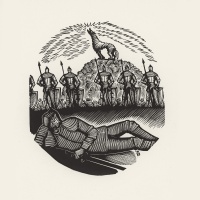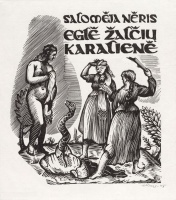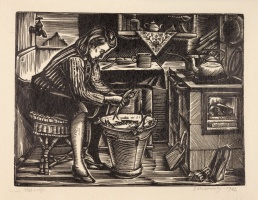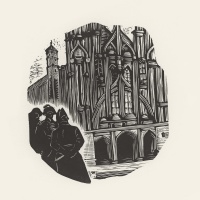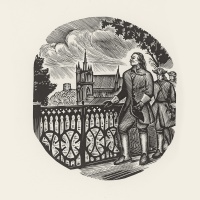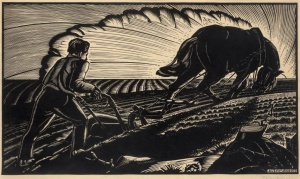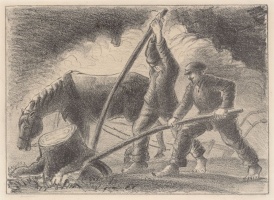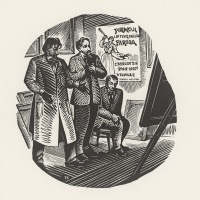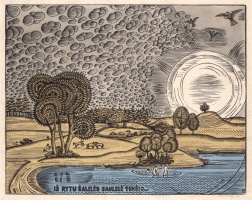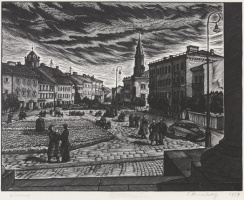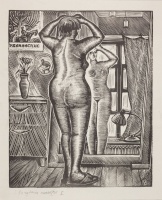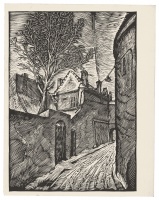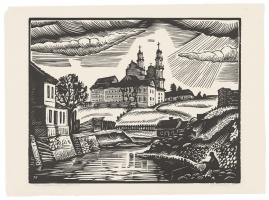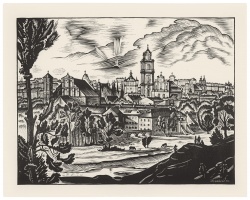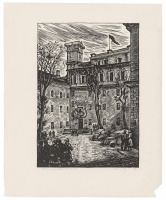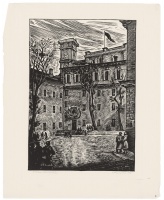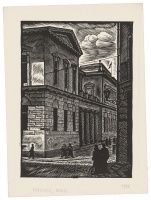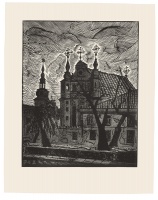
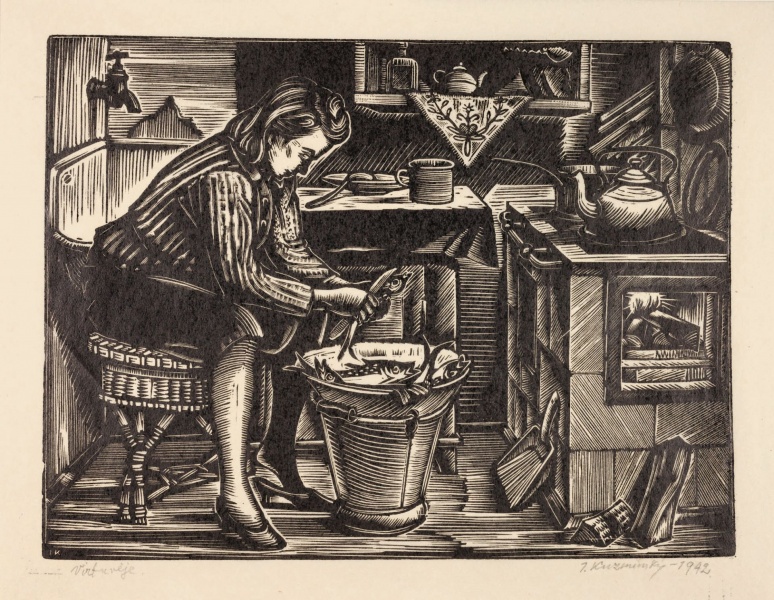

In the kitchen
| Author: |
Jonas Kuzminskis (1906–1985) |
| Created: | 1942 |
| Material: | paper |
| Technique: | woodcut |
| Dimensions: | 19 × 23.50 cm |
| Signature: | bottom left: JK / Virtuvėje, right: J.Kuzminskis - 1942. |
This is a personal picture which helps us imagine the living conditions of the graphic artist Jonas Kuzminskis (1906–1985) and his wife during the Second World War. The print shows a woman in a small kitchen sitting on a wicker chair and cleaning fish, which she takes from an enamelled bowl resting on a tin bucket. Logs are blazing in the stove, on which a kettle is boiling. The artist was very attentive to the world around him, and represented accurately the interior of his flat in Užupis, with its simple furniture and tableware. According to Gražina Drėmaitė, who knew the Kuzminskis family very well, the artist and his wife lived quite comfortably during the war, as their relatives from the country supplied them with food. Kuzminskis sometimes shared the food with Vladas Drėma, whose life was much harder. In its theme and its iconography, Kuzminskis’ print recalls the lithograph Peeling potatoes (1937) by Veronika Šleivytė (1906–1998), who depicted her mother Barbora Šleivienė concentrating on the mundane chore, which was well received by wartime critics. Lithuanian artists took little interest in daily life as a theme in the first half of the 20th century, and pictures of work were rare. A woman preparing food (in this case cleaning fish) is an iconographic theme which connects Kuzminskis’ woodcut with the linocut Peeling potatoes (1936) by Marcė Katiliūtė (1912–1937), an artist whose dramatic fate made her close to him
Text author Giedrė Jankevičiūtė
Lithuanian artists managed to organise several group exhibitions in Kaunas, Ukmergė, Telšiai and Vilnius during the German occupation. However, a confrontation with the German censors could not be avoided in an exhibition held at the Vilnius Art Museum in the spring of 1944. By order of Hinrich Lohse, the commissar of the occupying authorities, paintings by Antanas Gudaitis and Viktoras Vizgirda were removed from the exhibition, as examples of ‘degenerate art’ (entartete Kunst) (Antanas Gudaitis: tekstai ir vaizdai [Antanas Gudaitis: Texts and Images], compiled by Eglė Kunčiuvienė, Ema Mikulėnaitė, Vilnius, 2020, p. 117). Lohse was probably displeased by the Expressionist features in the portraits and landscapes painted by the members of the Ars group.
The landscape was the most common genre during the war. It was ideologically neutral and acceptable to the censors, and was therefore often exhibited and willingly bought by the public. Architectural landscapes depicting the newly returned capital could often be seen in works by Jonas Kuzminskis (1906–1985). One of his engravings in the series ‘Old Vilnius’ depicts a view of the Old Town with the building of Vilnius Academy of Art, in which he taught from 1941 after arriving from Kaunas. During the war, artists often turned their attention to close and ordinary domestic life. Kuzminskis’ composition In the kitchen, depicting his wife cleaning fish in the family’s small kitchen, is typical of that time.
Text authors Dovilė Barcytė and Ieva Burbaitė
Source: Law firm Valiunas Ellex art album OBJECTS ON SHOW (2017). Compiler and author Giedrė Jankevičiūtė, KAUNAS–VILNIUS / 1918–1945 (2021). Compilers and text authors Dovilė Barcytė and Ieva BurbaitėExpositions: "1918-1945 / Kaunas-Vilnius", 27 August 2020 – 21 August 2021, Lithuanian Art Centre TARTLE (Užupio St. 40, Vilnius). Curators Dovilė Barcytė and Ieva Burbaitė.







